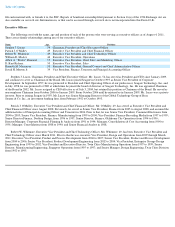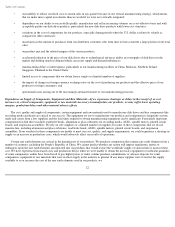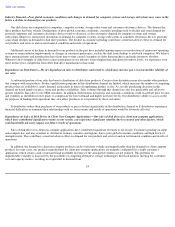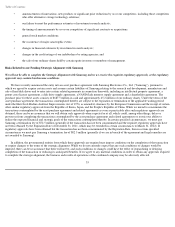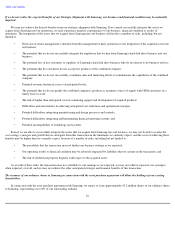Seagate 2010 Annual Report Download - page 29
Download and view the complete annual report
Please find page 29 of the 2010 Seagate annual report below. You can navigate through the pages in the report by either clicking on the pages listed below, or by using the keyword search tool below to find specific information within the annual report.
Table of Contents
Dependence on Key Customers
—We may be adversely affected by the loss of, or reduced, delayed or cancelled purchases by, one or more of
our larger customers.
Some of our key customers, including Hewlett-Packard Company, Dell Inc. and EMC Corporation, account for a large portion of our disk
drive revenue. While we have longstanding relationships with many of our customers, if any of our key customers were to significantly reduce
their purchases from us, our results of operations would be adversely affected. While sales to major customers may vary from period to period, a
major customer that permanently discontinues or significantly reduces its relationship with us could be difficult to replace. In line with industry
practice, new customers usually require that we pass a lengthy and rigorous qualification process at the customer's cost. Accordingly, it may be
difficult or costly for us to attract new major customers. Additionally, mergers, acquisitions, consolidations or other significant transactions
involving our customers generally entail risks to our business. If a significant transaction involving any of our key customers results in the loss
of or reduction in purchases by these key customers, it could have a materially adverse effect on our business, results of operations, financial
condition and prospects.
Impact of Technological Change
—Increases in the areal density of disk drives may outpace customers' demand for storage capacity.
The rate of increase in areal density, or storage capacity per square inch on a disk, may be greater than the increase in our customers'
demand for aggregate storage capacity, particularly in certain market applications like client compute. As a result, our customers' storage
capacity needs may be satisfied with lower priced, low capacity disk drives. These factors could decrease our sales, especially when combined
with continued price erosion, which could adversely affect our results of operations.
Changes in Electronic Data Storage Products—Future changes in the nature of electronic data storage products may reduce demand for
traditional disk drive products.
We expect that in the future, new personal computing devices and products will be developed, some of which, such as Internet appliances,
tablet or mobile phones with advanced capabilities, or smartphones, may not contain a disk drive. While we are investing development resources
in designing disk drives for these new applications, these new applications may have an impact on future demand for disk drive products.
Products using alternative technologies, such as flash memory, optical storage and other storage technologies, are becoming increasingly
common and could become a significant source of competition to particular applications of our products, which could adversely affect our results
of operations.
New Product Development and Technological Change
—If we do not develop products in time to keep pace with technological changes, our
results of operations will be adversely affected.
Our customers have demanded new generations of disk drive products as advances in computer hardware and software have created the
need for improved storage products, with features such as increased storage capacity, improved performance and reliability and lower cost. We,
and our competitors, have developed improved products, and we will need to continue to do so in the future. Such product development requires
significant investments in research and development. We cannot assure you that we will be able to successfully complete the design or
introduction of new products in a timely manner, that we will be able to manufacture new products in sufficient volumes with acceptable
manufacturing yields, that we will be able to successfully market these new products or that these products will perform to specifications on a
long-term basis. In addition, the impact of slowing areal density growth may adversely impact our ability to be successful.
When we develop new products with higher capacity and more advanced technology, our results of operations may decline because the
increased difficulty and complexity associated with producing these products increases the likelihood of reliability, quality or operability
problems. If our products suffer
26


